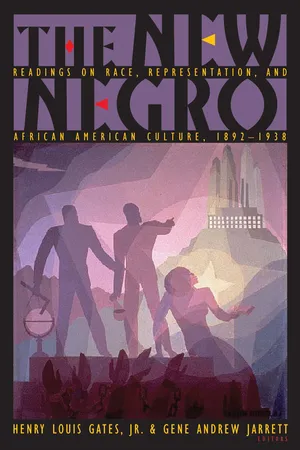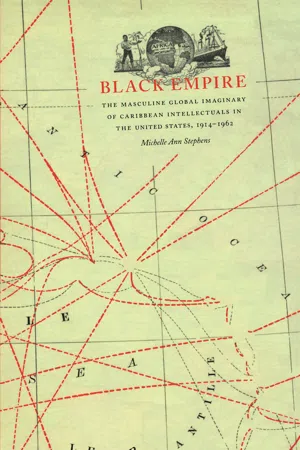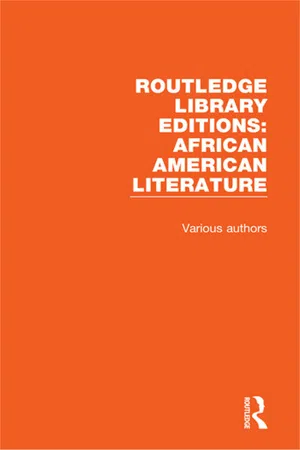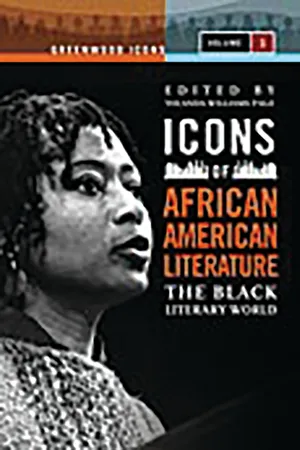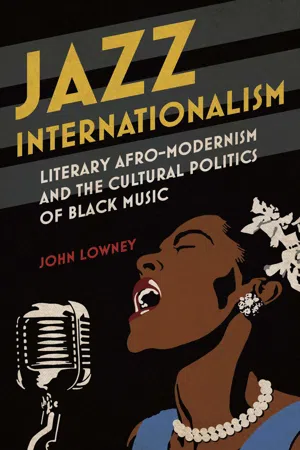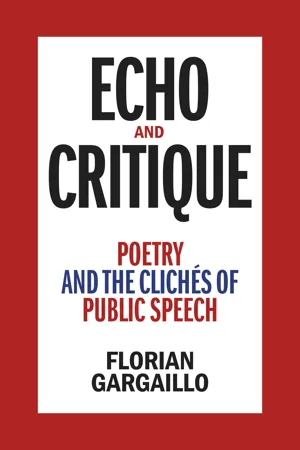History
Claude McKay
Claude McKay was a key figure in the Harlem Renaissance, a cultural movement that celebrated African American art and literature in the 1920s. He was a Jamaican-American writer and poet known for his works that explored themes of racial and social injustice. McKay's poetry and novels, such as "Home to Harlem," made a significant impact on the African American literary tradition.
Written by Perlego with AI-assistance
Related key terms
1 of 5
8 Key excerpts on "Claude McKay"
- eBook - ePub
The New Negro
Readings on Race, Representation, and African American Culture, 1892-1938
- Henry Louis Gates, Gene Andrew Jarrett, Henry Louis Gates Jr., Gene Andrew Jarrett(Authors)
- 2021(Publication Date)
- Princeton University Press(Publisher)
But taking up the contemporary triumvirate—McKay, Cullen, and Hughes—all of whom have had volumes published by reputable houses and are fairly well known to the poetry-reading public, we have poets of another type. Each one of them represents a different trend in Negro literature and life.Claude McKay was born in Jamaica, British West Indies, where he received his elementary education, served a while in the constabulary, and wrote his first poems. A friend financed his journey to America to finish his scholastic work, but McKay found himself at odds with the second-rate schools he attended here and finally fled to New York City where he became a member of the old Masses , Seven Arts , Liberator group of radicals and artists. During this period he received a legacy which, he tells us, was spent in riotous living. Broke, he attempted to make a living by washing dishes, operating elevators, doing porter work—the usual occupations engaged in by Negro artists and intellectuals.McKay’s first volume was published while he was still in Jamaica, a compilation of folk-verse done in the native dialect. The Institute of Arts and Sciences of Jamaica gave him a medal in recognition of this first book. It is in many ways remarkable, and in it the poet gives us a more substantial portrait and delves far deeper into the soul of the Jamaican than Dunbar was ever able to in the soul of the southern Negro in America.McKay’s latter poetry is often marred by bombast. He is such an intense person that one can often hear the furnace-like fire within him roaring in his poems. He seems to have more emotional depth and spiritual fire than any of his forerunners or contemporaries. It might be added that he also seems to have considerably more mental depth too. His love poems are not as musical or as haunting as Mr. Cullen’s, but neither are they as stereotyped. His sonnet to a Harlem dancer may not be as deft or as free from sentiment as “Midnight Man” by Langston Hughes, but it is far more mature and moving. All of which leads us to say that a study of Claude McKay’s and of the other better Negro poetry convinces us that he, more than the rest, has really had something to say. It is his tragedy that his message was too alive and too big for the form he chose. His poems are for the most part either stilted, choked, or over-zealous. He could never shape the flames from the fire that blazed within him. But he is the only Negro poet who ever wrote revolutionary or protest poetry. Hence: - eBook - PDF
Black Empire
The Masculine Global Imaginary of Caribbean Intellectuals in the United States, 1914–1962
- Michelle Ann Stephens, Donald E. Pease(Authors)
- 2005(Publication Date)
- Duke University Press Books(Publisher)
129 chapter 5 Claude McKay and Harlem, Black Belt of the Metropolis As the setting sun sets its last crimson light from the heights that hold the Hudson from the Harlem, it floods 138th Street and lights three blocks. One is a block of homes built by the Equitable Life Insurance Society, but now sold to negroes, some crowded, some care-lessly kept, but most of them beautiful, even luxurious, perhaps as handsome a block as middle-class America, white or black, a√ords. —w. e. b. du bois ∞ in his essay ‘‘The Storyteller,’’ Walter Benjamin describes two di√erent tellers of stories: ‘‘someone who has come from afar’’ and ‘‘the man who has stayed at home.’’ He continues: ‘‘If one wants to picture these two groups through their archaic representatives, one is embodied in the resident tiller of the soil.’’ ≤ This storyteller is a common figure for the African American writer during the years leading up to and during the Harlem Renaissance. In Charles Chesnutt’s classic The Conjure Woman or Jean Toomer’s Cane , these story-tellers reconstructed for new black migrants to the North local tales and traditions from their Southern past. ≥ They created stories that, in nurturing the memory, history, and tradition of community, remedied the dislocation experienced by black subjects upon their great migration north. While Claude McKay has always been seen as one of the leading literary forerunners of the Harlem Renaissance, he also stands in a peculiar relation-ship to this African American tradition. McKay was someone come from afar in more than one sense of the word. Born in Jamaica, McKay migrated to the United States in 1912 at age twenty-two, spent seven years in America, and then traveled to London where he settled for over a year and a half. He returned to New York in the winter of 1921, but in less than a year he signed on - eBook - ePub
Cultural Entanglements
Langston Hughes and the Rise of African and Caribbean Literature
- Shane Graham(Author)
- 2020(Publication Date)
- University of Virginia Press(Publisher)
His earliest poems take their themes from his native Jamaica, and many of them are written in Jamaican vernacular dialect, making him an important figure in the history of Caribbean literature. But he left Jamaica for the United States in 1912 at the age of twenty-two and would never again live in the West Indies or write poetry in the Jamaican patois. Partly by virtue of his association with the Harlem Renaissance and the inclusion of his writing in such important anthologies as Alain Locke’s The New Negro, Langston Hughes and Arna Bontemps’s The Poetry of the Negro, and David Levering Lewis’s Harlem Renaissance Reader, McKay is often counted as an honorary African American. But he spent most of the crucial years of the Harlem Renaissance (roughly 1917–29) living not in Harlem but in England, Russia, southern Europe, and northern Africa. The most profound precedent that McKay set for the younger Hughes, I maintain, was an aesthetic deeply planted both in politics and in the soil of ordinary people’s cultural life. Hughes drew vernacular influences from Whitman, Sandburg, and Dunbar as well, but McKay’s brand of proletarian art had a demanding political urgency to it that appealed to Hughes the radical sloganeer who would emerge in the 1930s. The defiant political stance McKay took or implied in his writings might well have emerged from his admiration for Russian literature and his engagement with Soviet society, which, as Kate Baldwin notes, “produced theories about using culture not only as a tool of internationalism but also interracialism.” 19 Wayne Cooper, in one of his section introductions in The Passion of Claude McKay, argues that McKay had a vision of black identity very different from the elitism of Du Bois’s belief in the “talented tenth”: “McKay pushed forward in his novels and stories the ignorant black folk of farm and city as the potential directors of their own fate - eBook - ePub
Kindred Spirits
Friendship and Resistance at the Edges of Modern Catholicism
- Brenna Moore(Author)
- 2021(Publication Date)
- University of Chicago Press(Publisher)
5Friendship and the Black Catholic Internationalism of Claude McKay
Introduction
WHEN THE POET Claude McKay converted to Roman Catholicism in 1944, his old friends were horrified, reacting almost as if he had died.1 McKay was a Jamaican-born writer of the Harlem Renaissance, active in Black radical circles most of his life. To add to the shock of his baptism, he told his good friend, the Black Catholic writer Ellen Tarry, that he was more of a “European Catholic” than “an American one.”2 Yet McKay was an artist who had made his name in deliberate resistance to European aspirational culture and aesthetics: his writings instead evoked the sounds and sensibilities of voices from the rural Jamaican hill towns where he grew up; the African immigrant dockworkers who made a living in the shipyards of southern France; and Harlem’s Black dining car waiters, drifters, street preachers, and sex workers. He was at odds with what he perceived as the elitism of figures like W. E. B. Du Bois and the idea of cultivating a talented tenth to uplift the race. McKay spent his life refusing to wear what he called the “borrowed robes of hypocritical white respectability.”3 But by 1944, Claude McKay had become a European Catholic?In recent years, McKay’s connections to Europe as well as to the Caribbean and the United States have drawn the attention of scholars interested in Black cultural expression beyond, according to Brent Hayes Edwards, the more standard “U.S.-bound themes of cultural nationalism, civil rights protests, and uplift in the literary culture of the ‘Harlem Renaissance.’”4 Indeed, McKay offers us a nearly paradigmatic example of Paul Gilroy’s notion of transatlantic Black modernism.5 Born in Jamaica, McKay immigrated to the United States in 1912 and ended up in Harlem in 1914. He was a gifted poet: his collection Harlem Shadows (1922) propelled him to become “the most famous poet among black Americans” and is today viewed as one of the texts that inspired the Harlem Renaissance, and in 1928, McKay published one of the first best-selling novels of African American literature, Home to Harlem.6 - Various Authors(Author)
- 2021(Publication Date)
- Routledge(Publisher)
Consequently, the fourteen month trip to the Soviet Union, China, and Japan in 1932 and 1933 represented the pinnacle of Langston Hughes's expatriate experience. There are many points of comparison between Claude McKay and Langston Hughes. Both Hughes and McKay evolved as writers during the Harlem Renaissance era. Indeed, they acted 88 Black Writers Abroad as key leaders of that movement, though unlike Hughes, McKay lived outside of America during much of the Renaissance period, causing him to be labelled by Alain Locke as an outsider. 58 Ironically, McKay's removal did not impair his understanding of what the Harlem Renaissance meant as an important cultural phenomenon, as Harold Cruse claims: Claude McKay ... could view the Harlem Renaissance both as a participant and as an objective but interested outsider. In so doing he unwittingly revealed important aspects of the Harlem Renaissance that Hughes wouldn't have told if he could. 5 9 Significantly, part of McKay's role as an interested outsider was to criticize some of the ambivalent and contradictory elements of the Renaissance from a mind that seemed more critical and political than Hughes, and which expressed its thoughts more openly. Both writers, however, drew intellectual and emotional sustenance from their love of black people and, especially, black folk culture, which gave them an identity to help offset the negative effects of divided consciousness and alienation. As such, they reawakened the concept of a cohesive and unified black identity as expressed by some 19th century slave narrative and black emigrationist writers. Yet, McKay's black consciousness was more developed than Hughes, more grounded to social conditions. On the other hand, if both writers loved black people, they disliked the black middle class, who often attacked their writings for sensationalism and vulgarity.- eBook - PDF
Icons of African American Literature
The Black Literary World
- Yolanda Williams Page(Author)
- 2011(Publication Date)
- Greenwood(Publisher)
But while studying, he observes a lynching that provokes him to want to pass (a term referring to a fair-skinned African American pretending to be white). He makes the decision, commits to the idea, and consummates his choice with a marriage to a white woman with whom he has children. He continues his ruse and later writes his autobiography. The novel’s significance comes in two parts. First, the novel did not experi- ence great success when it was first published, even though it was well writ- ten; Johnson believed that the work was unsuccessful in large part because it was before its time (Wintz 60). Supporting that idea is the fact that the work’s most significant impact came almost a decade later during the Harlem Renaissance; the text really seemed to resonate among the young talent, who began to understand what Johnson was saying. Second and most importantly, the novel began to change the course of the conversations and paradigms. No longer simply discussing the travesties experienced by African Americans at the hand of white Americans, Johnson began to pose new questions: Who are we now? What does it really mean to be black? Can I use my artistic ability to explain and/or express the reality of being an African American in America (Wintz 67)? If Johnson can be said to have laid a foundation for the prose of the Harlem Renaissance, then Claude McKay (1889–1948) can be said to have provided the poetic foundation for the movement. McKay was born to a middle-class Jamaican family where he was the youngest of 11 children, and he was first educated by his brother, who was a teacher. During his early teen years, he was composing his own poetry, and it was then that he had his first contact with Walter Jekyll, a British folklorist who mentored McKay in many things. 116 Icons of African American Literature Jekyll provided McKay with additional literary works beyond what his broth- er’s school could provide, and he encouraged him to write dialect poetry. - eBook - ePub
Jazz Internationalism
Literary Afro-Modernism and the Cultural Politics of Black Music
- John Lowney(Author)
- 2017(Publication Date)
- University of Illinois Press(Publisher)
15In his retrospective account of post–World War I Harlem, Harlem: Negro Metropolis (1940), McKay concurred with the New Negro celebration of Harlem as a cosmopolitan “Negro Capital.” He wrote that Harlem was “more than the Negro capital of the nation. It is the Negro capital of the world. And as New York is the most glorious experiment on earth of different races and divers [sic ] groups of humanity struggling and scrambling to live together, so Harlem is the most interesting sample of black humanity marching along with white humanity” (16). Unlike Locke, however, McKay identified this emergent “cultural center” in the post–World War I years with Marcus Garvey, the leader of “African Zionism” (20), who brought worldwide attention to Harlem. Harlem was indeed distinctive in its mix of Caribbean and African immigrants as well as blacks from the United States, and Garvey was the figure who most embodied the transnational implications of the “New Negro”: “The flowering of Harlem’s creative life came in the Garvey era. The anthology, THE NEW NEGRO, which oriented the debut of the Renaissance writers, was printed in 1925. If Marcus Garvey did not originate the phrase, New Negro, he at least made it popular” (177). While McKay’s retrospective celebration of Garvey is informed by his disdain for communism in the 1930s as well as by his commitment to Pan-Africanism, he identifies “New Negro” Harlem with working-class blacks. And his consideration of black popular entertainment, or “the business of amusements” (117–20), likewise focuses on the exploitation of black workers, including performing artists, as well as the working-class pursuit of pleasure in cabarets. Indeed, his distinction between black-owned cabarets before Prohibition and their successors is especially important for Home to Harlem - eBook - ePub
Echo and Critique
Poetry and the Clichés of Public Speech
- Florian Gargaillo(Author)
- 2023(Publication Date)
- LSU Press(Publisher)
4 CLAUDEMcKAY ON THE POLITICALCLICHÉS OF THE HOMEFRONTAs we have seen, World War II proved to be the defining event in the development of echo and critique after Auden began to adopt this method in the years leading up to the conflict. Yet in the history of echo and critique’s postwar expansion, Claude McKay matters especially because the rhetorical context he responded to was not, in fact, the war. Whereas Jarrell and Hughes examined how military propaganda beautified or erased the real-life experiences of soldiers and African Americans, McKay focused on the stock phrases surrounding domestic politics in the United States and studied the way that these obscured or distorted social realities. The phrases that interested him most fell under two categories: first, the nationalist rhetoric of community and shared values; and, second, the rhetoric of protest in support of labor rights or civil rights. McKay’s focus matters because it is so easy, in retrospect, for the war to dominate our view of the political situation in the United States and the rhetoric that poets critiqued. McKay’s work is a record of the domestic struggle around inequality that persisted in this period, and how poets sought to confront its ramifications in the realm of political language.Like Jarrell and Hughes, McKay was fascinated by propaganda. But his relation to mass political persuasion was, arguably, even more complicated than that of either of his contemporaries. From 1919 (when he began a three-year stint as coeditor of the socialist magazine the Liberator with Max Eastman) to 1928 (when he published his first novel, Home to Harlem ), McKay embraced propaganda as a necessary tool in combating racism and colonialism. In a letter to Francine Budgen from August 1920, he noted, casually but with obvious excitement: “I am merely doing my bit of propaganda to offset that of the anti-Negro Americans, the colonial whites, and prejudiced Englishmen.”1 His most notable public statement on propaganda during this time, though, is the essay “Soviet Russia and the Negro,” published in Crisis in December 1923. In it, McKay begins with a bold assertion intended to provoke: “The label of propaganda will be affixed to what I say here. I shall not mind; propaganda has now come into its respectable rights and I am proud of being a propagandist.”2 He then expands the meaning of propaganda to encompass any work of art that seeks a political outcome. He does so by tracing how his literary taste evolved over time. After devoting most of his boyhood to the “gilt-washed artificiality” of style for style’s sake (as exemplified by Oscar Wilde’s The Picture of Dorian Gray ), he “lighted on one of Milton’s greatest sonnets that was pure propaganda and a widening horizon revealed that some of the finest spirits of modern literature—Voltaire, Hugo, Heine, Swift, Shelly, Byron, Tolstoy, Ibsen—had carried the taint of propaganda.” That broader view “swung me away from the childish age of the enjoyment of creative work for pleasurable curiosity to another extreme where I have always sought for the motivating force or propaganda intent that underlies all literature of interest.”3 Such a narrative accomplishes two things. First, the conflation of “propaganda” with the vagueness of “a motivating force” sweeps under that heading all works that have political ideas to communicate. Second, the biographical narrative enables McKay to peg as “childish” any interest in art distinct from politics. “Another extreme” concedes there may be limits to his new perspective on art, but the gesture seems largely empty. Those limits are never spelled out, and the rest of the essay advocates for the importance of propaganda both as a tool for progress (“American Negroes are not as yet deeply permeated with the mass movement spirit and so fail to see the importance of organized propaganda”) and as a threat that had to be reckoned with (“It was not until I first came to Europe in 1919 that I came to a full realization and understanding of the effectiveness of the insidious propaganda in general that is maintained against the Negro race”).4
Index pages curate the most relevant extracts from our library of academic textbooks. They’ve been created using an in-house natural language model (NLM), each adding context and meaning to key research topics.
